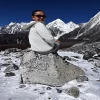The Manaslu Circuit Trek takes you around Mt. Manaslu, the world's 8th highest mountain (8,156m). Starting with a long but scenic drive from Kathmandu to Machha Khola, your adventure truly begins as you pass through lush forests, cross swaying suspension bridges, and pass terraced fields to reach Machha Khola.
Over the next few days, you will journey through charming villages like Doban (where two rivers meet) and Philim. The trail then leads to Deng, a Buddhist village with monasteries and your first glimpses of snow peaks. As you climb higher, you will notice more Buddhist influences like mani walls, prayer flags, and stone carvings. You will find those especially in Ghap, Samagaon, and Namrung, where breathtaking views of Ganesh Himal and Himalchuli await.
The trek continues to Lho and Samagaun, a picturesque stone village where you will rest for a day to acclimatize. Here, you can explore Birendra Lake, Pungyen Monastery, or even hike to Manaslu Base Camp. Next, you will head to Samdo, a Tibetan refugee village with jaw-dropping mountain vistas, before preparing for the toughest part: crossing the Larkya La Pass(5,160m). This challenging but rewarding section takes you past glaciers and frozen lakes, with panoramic views of Annapurna II and other giants.
After descending to Bhimtang, you will trek through pine forests to Dharapani, where the Manaslu and Annapurna trails meet. A final bus ride returns you to Kathmandu, marking the end of an unforgettable journey.
Why Trekkers Love It:
- Less crowded than Everest or Annapurna
- Stunning diversity: forests, glaciers, and Tibetan culture
- The thrilling Larkya La Pass crossing
Opened in 1992, the Manaslu Circuit remains a hidden gem and is perfect for those seeking adventure off the beaten path!
13 days Outline Itinerary for Manaslu Circuit Trek
Day | Route | Altitude (m/ft) | Duration | Remarks |
1 | Drive Kathmandu → Maccha Khola | 930m/3,051ft | 9 hrs | Scenic drive to the trek start point |
2 | Trek Maccha Khola → Jagat | 1,340m/4,396ft | 6 hrs | Follow Budhi Gandaki River |
3 | Trek Jagat → Deng | 1,804m/5,918ft | 6 hrs | Enter restricted area (permits) |
4 | Trek Deng → Namrung | 2,630m/8,628ft | 6 hrs | Views of Shringi Himal |
5 | Trek Namrung → Lho | 2,957m/9,701ft | 4 hrs | First views of Manaslu (8,163m) |
6 | Trek Lho → Sama Gaun | 3,530m/11,581ft | 4 hrs | Buddhist monasteries & culture |
7 | Acclimatization Day (Sama Gaun) | Day trip to BC/Pungyen Gompa | 7 hrs | Explore or rest |
8 | Trek Sama Gaun → Samdo | 3,865m / 12,680ft | 3 hrs | Tibetan-influenced village |
9 | Acclimatization Day (Samdo) | Day trip to Tibet Border (5,000m/16,404ft) | 8 hrs | High-altitude hike |
10 | Trek Samdo → Dharmasala | 4,460m / 14,632ft | 4 hrs | Prepare for Larkya Pass |
11 | Trek Dharmasala → Bimthang (via Larkya Pass) | 3,590m / 11,778ft (after crossing 5,160m/16,929ft pass) | 10 hrs | Longest & toughest day |
12 | Trek Bimthang → Dharapani | 1,970m / 6,463ft | 7 hrs | Descend to the Annapurna Circuit route |
13 | Drive Dharapani → Kathmandu | 1,300m / 4,265ft | 10 hrs | Return via jeep/bus |
Difficulty Level Of Manaslu Circuit Trek
The Manaslu Circuit Trek is considered a moderate to challenging trek, suitable for trekkers with some prior hiking experience and good physical fitness. Here is what makes it demanding and ways to prepare:
1. High Altitude (Up to 5,160m at Larkya La Pass)
- The trek crosses Larkya La Pass (5,160m), where altitude sickness (AMS) is a real risk.
- Proper acclimatization days (in Samagaun & Samdo) are crucial.
- Symptoms like headaches, nausea, and dizziness must be monitored.
2. Long Trekking Days (5–8 Hours Daily)
- Some days involve 7–10 hours of walking, especially the Larkya Pass crossing day (10+ hours).
- Trails are rocky, steep, and uneven, with occasional landslides.
3. Remote & Basic Conditions
- Limited electricity, Wi-Fi, and hot showers at higher elevations.
- Accommodations are simple teahouses with shared bathrooms.
- Medical facilities are scarce—carry a first aid kit.
4. Weather Extremes
- Cold nights (can drop below -10°C at high camps).
- Unpredictable snow (especially in winter/spring) and strong winds near Larkya La.
Tips to Manage Difficulty
- Train for 2–3 months (hiking with a 10kg backpack, cardio, and leg strength).
- Walk slowly, stay hydrated (3–4 L water/day), and follow acclimatization rules.
- Pack wisely (warm layers, sturdy boots, trekking poles).
Best Season For Manaslu Circuit Trek
You can experience the excitement of the Manaslu Circuit Trek in Nepal, a trekking journey that differs with each season. Throughout Spring (Early March to End of May), it brings colorful rhododendron blooms in the lower regions of Deng and Shyala. With amazing temperature levels and bright sunshine, it’s an ideal time for trekking. However, be prepared for crowded trails because of the peak season and potentially warm climate by mid-May.
In Summer (June to mid-September), the summer monsoon season in Nepal brings cooler temperature levels as well as rainfall. Most trekkers are prevented from this period as a result of muddy and slippery trail conditions and also the visibility of leeches and mosquitoes. Additionally, swollen streams and potential landslides can present obstacles.
Fall (Late September to mid-December) is considered the best time to discover the Manaslu Circuit Trek. The weather conditions are perfect for climbing Larke Peak, and the clear skies offer spectacular sights of the snow-capped mountains. Nonetheless, the popularity of this season means crowded trails and higher prices for restricted permits.
Winter season (Late December to Early March) on the Manaslu Circuit Trek brings dropping temperature levels, with the potential for temperatures as low as -8 degrees Celsius. Trekking to Manaslu Base Camp can be risky due to snow-covered routes, and many teahouses in the upper region are closed. Therefore, this trek is best enjoyed during spring and autumn.







